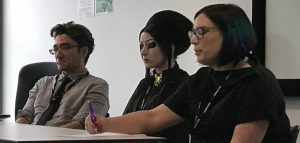The world of yōkai has been fascinating me of late. These creatures are currently popular in anime, manga, film and computer games, but they originated in local legends in Japan, folktales and regional ghost stories. I was excited to attend the Japanese Gothic panel at the recent IGA (pictured below). This featured research by Alex Watson on the films of Kurosawa, Jenevieve Van-Veda on Japanese gothic art, and Catherine Spooner on hybridising Shōjo manga and British Gothic in Yana.

I had begun my own journey to the East some months earlier when, in relation to my book on the shadow, I’d been browsing Tales of Old Japan by A. B. Mitford. Mitford, a British traveller to Japan in 1866-70, had witnessed the hara-kiri ceremony first hand and collected gripping tales of vampires and samurai, Buddhist sermons, and the plots of 4 Nō plays. His work was the first collection of Japanese tales to be published in English in 1871. From this I discovered the work of Toriyama Sekien, 1712-1788, 鳥山 石燕, an eighteenth-century scholar, poet, and artist. Sekien, his pen name, is best known for the illustrated books of yōkai that appeared in Hyakki Yagyō monster parade scrolls. The last of which features yōkai mainly out of Sekien’s own imagination. I have since found Michael Dylan Foster’s Pandemonium and Parade: Japanese Monsters and the Culture of Yōkai (2009) and discovered the work of the artist and scholar, Shinonome Kijin, but I’m only at the very beginning of my journey to the East and the wonderfully weird world of yōkai.
Do comment below with any suggestions re: useful books on Japanese folklore. Here is my first contribution to yōkaiology which I’ve entitled ‘Yokai & Me’. If you are interested you can use the hashtag #YōkaiFriday and join me in celebrating these wonders in the forthcoming weeks. They’re incredible, terrifying and amusing in equal proportions. I can’t wait to lean more.
Yōkai & Me – click on image to browse the monster parade
